| 1 | Gua Wang, Malaysia |
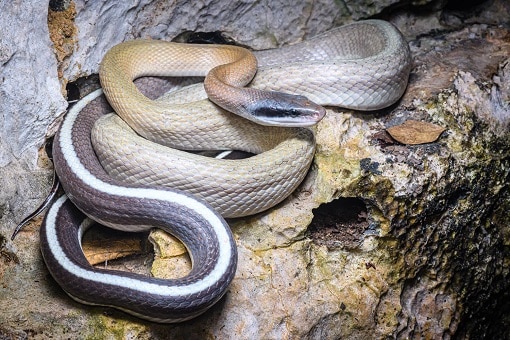
Gua Wang is located on the southern border of Thailand, opposite Peninsular Malaysia. Located in the forested Perlis National Park, the cave is under mankind’s control as much as can be, with detailed wooden signs at the entrance and a metal walkway throughout. Visitors are handed helmets with torches, and given a choice of two caves: the easier passage 1, or the tighter, more physically taxing passage 2. The gimmick is being able to enter a passage in Malaysia and emerge from the other side in Thailand, if you can suppress your claustrophobic panic instincts for long enough.
Gua Wang cave is ecologically rich, littered with insects, stalactites, and of course, shed skins. The first snake here is Ridley’s cave racer, probably the most cave-adapted snake in the world. It’s a subspecies of the beauty ratsnake, which is ghostly white, has a red tongue, and is adapted to bat-eating.
The second was discovered only in 2014. It’s called the Gua Wang Burma wolf snake, or Lycodon cavernicolus, and is known solely from this cave. The first two snakes were discovered 200 metres deep within the cave, in total darkness, and 2-3 metres high on the wall. The maximum length discovered was 50.8cm, and it was related yet genetically separate from the Butler’s wolf snake living nearby. Most wolf snakes have black and white bands, but the Gua Wang Burma version lacks them in adulthood. No fresh locations have been discovered since 2014 – Gua Wang Burma cave remains their sole confirmed habitat.
| 2 | Kantemó Bat Cave |
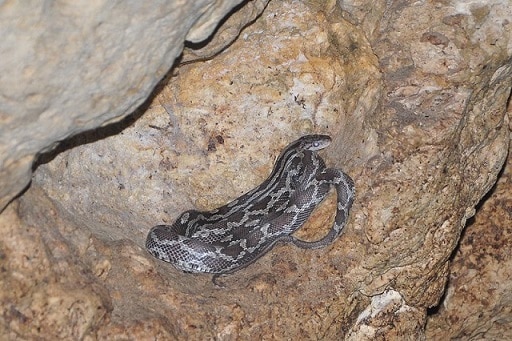
Kantemó Bat Cave lies near a tiny Mayan settlement on Mexico’s Yucatan peninsula, with just one church. For decades, the Mayans refused to enter the cave, considering it haunted by evil spirits. Bayona Miramontes had different ideas, and what he found was very different: 7 species of bats, and a vast amount of red-yellow ratsnakes.
The spot is now known as “hanging snake cave” and has a 65 foot wide entrance. The snakes and bats have an intricate relationship. By night, the bats fly out in their thousands to feed in Lake Chichancanab two miles away. Then the many snakes position themselves, hanging from the entrance. As the bats return, the slightest brushing triggers the snake’s hunting instinct, causing them to grab the bats and devour. The thousands of snakes live in crevices high in the cave’s walls and ceiling. Some will break the wings of larger bats and drag them into these crevices.
The cave also contains the blind brotula, a blind transparent eel, and originally contained ancient Mayan pots. Kantemó is now home to ever-increasing tourists, but the snakes continue their bat hunting unabated.
| 3 | Well of hell, Yemen |
The Well of Hell is one of Yemen’s most amazing natural landmarks. It’s a 150 metre wide pit just over the border from Oman, a black hole in the centre of the bone dry desert. Local superstition is endless; they believe it to be a portal to hell, or a supervolcano capable of destroying Earth. An unexplained foul smell emanates from the pit, theorised to be a prison for genies, or the souls of the damned. Some say that the sinkhole can suck people in if they stray too close.
In 2021, Mohammed Al-Kindi and 7 colleagues rappelled down the pit to discover the truth once and for all. Their previous record was 50-60 metres down, but this time they descended to the very bottom, safety be damned. They didn’t find genies or cursed spirits. Instead, the well was a total snake pit. There were slithery serpents all over the floor, along with dead birds, stunning green pearl formations, and stalagmites.
Fortunately, the research team managed to escape with their lives: “There were snakes, but they won’t bother you unless you bother them” said Al-Kindi. Another amazing feature were secret waterfalls, which started from 65 metres deep in the cave and plunged to the bottom, invisible to those above. Al-Kindi said that the cave smelled fine from within.
| 4 | Snake Palace (Istana Ular) |
An Indonesian chamber of nightmares, which might be the single worst place on Earth. Istana Ular is a long, straight, semi-flooded tunnel which stretches 100s of metres into a limestone hillside by a river. It’s believed to be an ancient lava tube, forged by violent magma expulsions long ago. The cave is home to a colony of reticulated pythons, the longest snake species on Earth. Locals refuse to go anywhere near the cave, believing that the pythons flock out en masse in the rainy season and snatch their cats and dogs.
The entrance is black and unforgiving, and when you enter, the horror somehow outstrips its reputation. Reptile expert Brady Barr entered this volcanic tube in 2007 with compatriots. The chamber was stifling, and the oxygen was severely reduced. The entire tunnel was full of bat slurry waist high, forcing them to wade through the shallower right side of the tunnel. There were maggots, roaches, spiders, lizards, and thousands of squeaking bats themselves.
Worse was that the cave was home to several 3 metre long reticulated pythons. Barr attempted to grab the tail of one as it slid through a crack in the wall. It was a mistake, as the furious python instantly swivelled 180 degrees and began coiling around Barr. He later said that the python’s power was astonishing, and in the melee, he felt the snake’s fangs sink into his left thigh. He let out an ear-piercing scream, and in the stifling heat of the slurry -filled cave, it was all he could do not to faint. The python continued biting, and tore downwards through his flesh.
Eventually, Barr and friends fled the cave, and reached a Singapore hospital, which wisely recommended not fully sewing the wound closed, to prevent infections from the vile snake chamber from being locked in. The whole python bite incident was captured on film. Watch it, if you must.
| 5 | Brandon Hill Cave, Honduras |
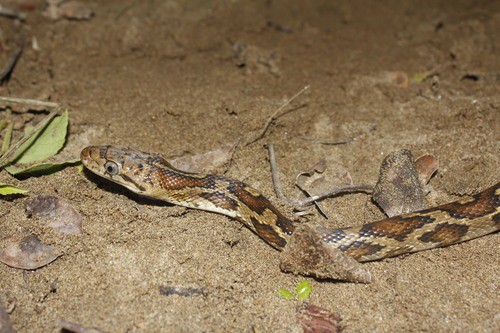
This is the most famous bat cave on the Honduran island of Utila. According to legend, pirates stashed their treasure here in the 16th and 17th centuries, including legendary Welsh pirate Henry Morgan. Locals believe that gold coins and riches are still hidden within the cavern and are determined to find them.
Brandon Hill cave is surrounded by forest, and is a cavernous limestone cave with 8 main chambers. It stretches 80 metres deep into the hillside, but could be longer, as that’s only the areas passable by humans. Brandon Hill cave is home to 6000 bats of 4 different species, including Merriam’s long-tongued bat and Tome’s sword-nosed bat.
The snake here is the yellow-red ratsnake, one of the same species at Mexico’s hanging cave. This large serpent has a strong tail which can bind to the cave’s roof and dangle down like a vine made from stone. They have a particular taste for one bat in Brandon Hill cave: the Mexican greater funnel-eared bat (Natalus mexicanus). Yellow-red ratsnakes have been found 40 metres deep in Brandon Hill Cave before. 5 have been seen hunting bats at once; thee had congregated in a particularly narrow part of the chamber, forcing the bats to funnel towards them. When resting, the ratnakes climb up to pockets in the cave’s porous rocky walls.
| 6 | Langun-Gobingob Cave |
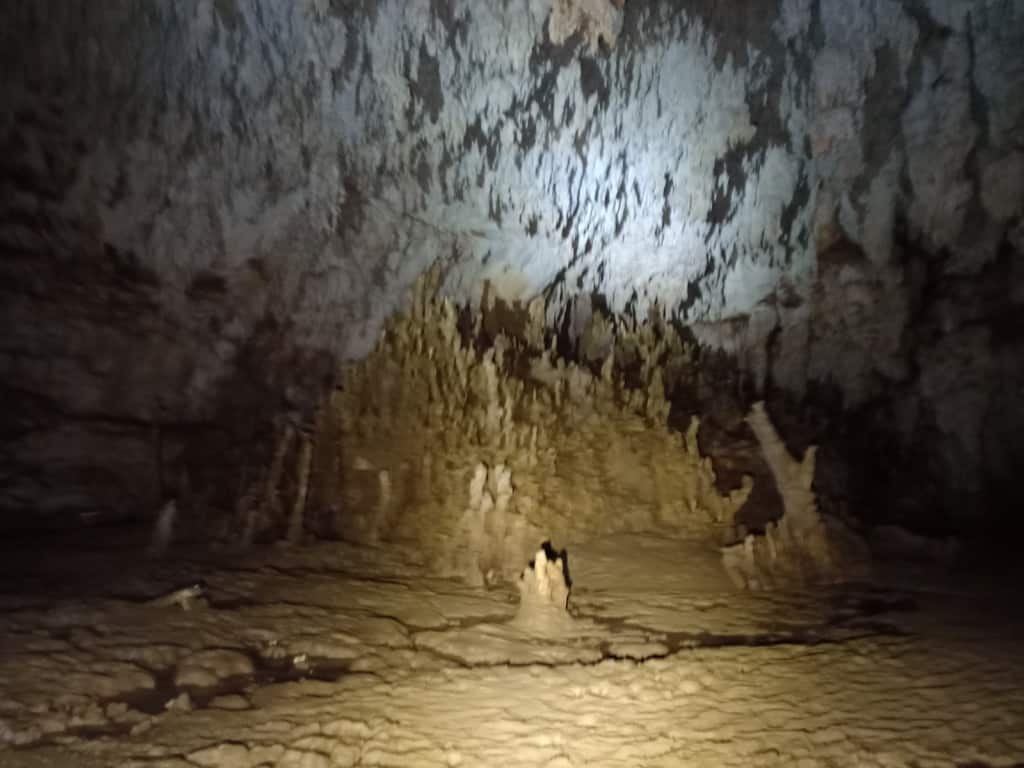
Langun-Gobingob cave is Indonesia’s longest, with 12 chambers and 7 kilometres of passages. This is a dark cavern of spikes and pillars, plus bats and an organic smell that tells you this is a living ecosystem. There’s rock formations galore, including a flowstone the size of a small skyscraper, made up of sparkling calcite crystals.
One of the chambers is as large as football pitch, before switching to narrow crawlspaces in mere seconds. Any caver must be equipped with a helmet-mounted headlamp, and they’re not alone: snakes are watching from every corner. The species in Langun-Gobingob is the Müller’s rat snake (Stegonotus muelleri), 1 metre long and black-yellow. Cavers will often have to drag snakes out of tight crawlspaces, or wait up to an hour for them to slither away of their own accord.
Caving diehards are forced to sleep in tents with the knowledge that the ratsnakes could slither right past them. The lower Langun caverns even have an area called the Snake Room where they congregate. This is accessible by a 3 metre rappel downwards, with little light to guide you. Fortunately, the Müller’s rat snake is a non-venomous, non-aggressive species.
| 7 | Cueva Castillo, Ecuador |
This Ecuadorian cave shot to global headlines in 2016, when the rainbow boa (Epicrates cenchria) was observed hunting a vampire bat for the first time. The common vampire bat relies solely on blood, not of humans, but of birds. Rather than dangling from stalactites, the rainbow boa was filmed plucking a vampire bat from the air from a ground position. It applied its coils, and the bat ceased struggling within 2 minutes, but the cautious boa clung on for another 7 minutes. It then swallowed the bat, which took 4 minutes and 50 seconds.
Castillo cave is located near the city of Ecuadorian city of Tena. The cave isn’t remote, as one of its entrances lies just 60 metres from the road. However, dense jungle lies between, which hides the cave from view. There are three entrances in total, a northern, western, and eastern entrance. This is a tight cave; the highest chambers only reach 3 metres tall, which are where the bats tend to congregate. This snake cave measures 450 metres deep, at least the passages that have been mapped.
| 8 | Persistence Cave |
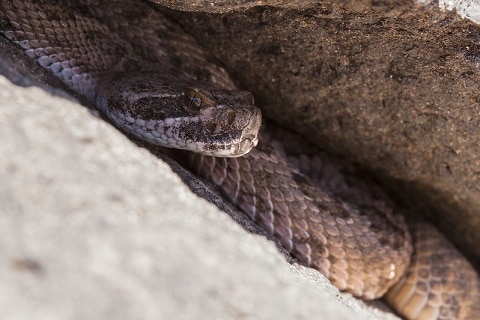
Persistence cave lies in South Dakota, with a tiny, pitch black entrance. The narrow caverns are filled with animal bones dating back 42,000 years, including pikas, frogs, black bears and bison. It’s a treasure trove for archaeologists, but there’s one small problem – it’s a prime den for prairie rattlesnakes.
Persistence cave was first discovered in 2004, when Marc Ohms saw a small alcove at the end of a ridge. He shifted a few boulders to reveal the entrance, and was instantly greeted by poison ivy and hissing rattlesnakes. He left the cave alone, assuming it was a mere snake den, but the hole turned out to be a fully fledged cave, 40 miles long if air pressure movements were to be believed.
The pull of history lured Ohms back in, snakes be damned, and archaeologists are now forced to constantly step over hissing rattlers. Marc Ohms was 50 feet deep in the cave in 2016, when he turned around and came face to face with a rattler 2 feet away, within easy striking distance. “We have to double check to make sure the rattlesnakes are not in our face, literally,” said Dr Jim Mead, lead researcher. The rewards are irresistible though – researchers regularly drag out bags containing hundreds of bones.
| 9 | Cueva de los Culebrones, Puerto Rico |
In English, this translates to “cave of the boas”, so don’t say they didn’t warn you. It lies inside the protected Mata de Plátano reserve, a moist forest region of karst limestone, with plenty of caves. Cueva de los Culebrones is a hot cave with a 5 metre wide, 3 metre high entrance. The main passage is 182 deep, with 3 separate chambers. The boas here are Puerto Rican boas, and hang out anywhere from inside the cave, to the entrance, to tall trees beyond the entrance.
Scientists examined Cueva de los Culebrones specifically in a study from 1994-96. The Caribbean boa family has prehensile tails, which are particularly strong next to other snakes, and they used them to dangle from the cave’s limestone entrance. They lowered 75% or more of their bodies down, and when gigantic bat flocks flew past, they swung upwards to grab them, with their tails still gripping. If successful, they instantly wrapped around two body coils, with the boa’s head submerged inside the coil.
The top boa at Cueva de los Culebrones managed to eat 4 bats in a single night. With over 300,000 bats estimated to inhabit the hot, humid cavern, this makes for easy pickings. The bats here are divided into 5 or 6 species – the largest is the Antillean fruit-eating bat, but the boas’ favourite was the buffy flower bat.
| 10 | Racer cave, Gunung Mulu |
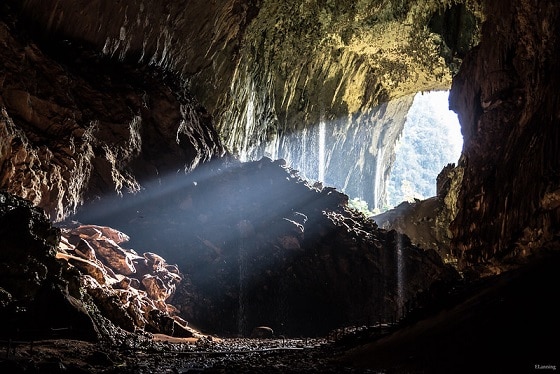
Gunung Mulu is a jungled national park in the Malaysian section of Borneo. It’s full of treacherous caves, with “advanced” level ones like Clearwater Connection and Sarawak Chamber, but the most snake-infested is only rated as intermediate. It’s called racer cave, and that’s because the signature species is again the Ridley’s cave racer.
The snake trouble starts on the trek in, where you’re stepping over pit vipers and dodging vine snakes pouncing from trees. Then you reach the cave itself. Rather than a nightmarish Halloween attraction with boas swinging from the entrance, this is a darker, quieter cave. It’s filled with stalagmites, plus the eroded bases of dead stalagmites, and ten minutes in the snakes start to appear. They appear in alcoves in the walls, in rocks in the corner, or poking their heads out of holes in the ceiling.
The Ridley’s cave racer has immense climbing skills and can reach almost anywhere. As you crawl deeper into the cave, you’d be very unlucky to miss the pale, glowing snakes on all sides. Racer cave is filled with tight crawlways and is pitch black, illuminated solely by the headlights of (possibly terrified) visitors. Ridley’s racers are harmless, but whether tour guides tell people that remains to be seen!
